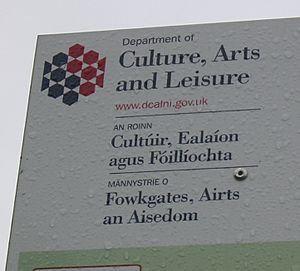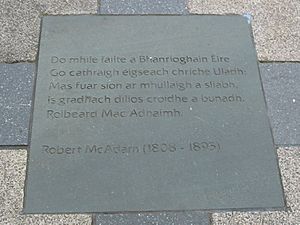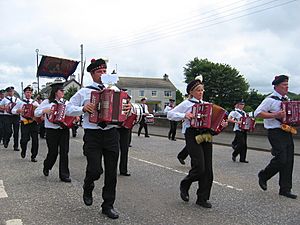Culture of Northern Ireland facts for kids
The culture of Northern Ireland is a mix of traditions from different places like Ireland, Scotland, and England. It has its own unique flavour, shaped by its history and the people who live there. You'll find a rich blend of heritage, food, languages, sports, and arts that make Northern Ireland special.
Contents
Heritage
Northern Ireland has many interesting places to explore its past. Since 1998, several important museums and parks have been looked after by the National Museums and Galleries of Northern Ireland. These include the Ulster Museum, the Armagh Museum, the Ulster Folk and Transport Museum, and the Ulster American Folk Park.
The Linenhall Library in Belfast is the oldest library in the city. It started way back in 1788 and has always aimed to give everyone access to books and local history.
Here are some other heritage spots:
- Abbeys and priories in Northern Ireland
- Gardens in Northern Ireland
- Giant's Causeway
- Museums in Northern Ireland
- National parks of Northern Ireland
Cuisine
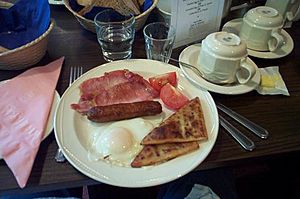
Northern Ireland has some tasty traditional foods. Two well-known chefs from the area are Paul Rankin and Michael Deane.
The most famous traditional meal is the Ulster fry. This is a big breakfast that usually includes bacon, eggs, sausages, soda bread, and potato bread. Other popular meals are fish and chips and 'Bangers and Mash' (sausages with creamy mashed potatoes).
A special sweet treat unique to Northern Ireland is Yellowman. It's a chewy, honeycomb-like toffee. You can often find it sold in blocks at the Ould Lammas Fair in Ballycastle, County Antrim. It's often sold with dulse there too.
Dulse is a type of seaweed that is eaten as a snack, especially along the Causeway Coast. It can also be used to make white soda bread. Many people still gather their own dulse along the coast.
Language
The most common language spoken in Northern Ireland is English. However, there are also two other important languages that are officially recognised. These are the Irish language and Ulster Scots, which is a local type of the Scots language.
Sign languages are also important. Northern Ireland Sign Language and Irish Sign Language have been recognised since 2004. British Sign Language is also used.
After English, Chinese was the most spoken language by minority groups in 2001. Other languages like Shelta, Arabic, and Portuguese were also spoken by many people. Since then, more languages from other European countries have become common due to new arrivals.
Sports
Many sports are very popular in Northern Ireland. Some team sports are played with teams from all over the island of Ireland. In other sports, Northern Ireland has its own separate team.
Some popular sports and teams include:
- Belfast Giants (ice hockey)
- Gaelic football
- Hurling
- Gaelic handball
- Milk Cup, an international youth football competition
- Northern Ireland national football team
- Royal Portrush Golf Club
- Ulster GAA (Gaelic games)
- Ulster Rugby (rugby union)
- Rowing
Northern Ireland has produced many famous sports stars, such as:
- George Best – a legendary footballer from Belfast
- Darren Clarke – a well-known golfer
- Joey Dunlop – a famous motorcycle racer
- Dame Mary Peters – an Olympic gold medalist in athletics
- Rory McIlroy – a world-famous golfer
- Alex Higgins – a snooker champion
Arts
Literature
Northern Ireland, even though it's small, has many famous writers and poets. Long ago, before the 1600s, Irish language literature was very important. The Ulster Cycle is a collection of old stories that are part of this history. Later, writers using the Ulster Scots language, like James Orr, created their own local style of writing.
Some well-known writers from Northern Ireland include:
- Ciarán Carson
- Brian Friel
- Seamus Heaney – a Nobel Prize-winning poet
- C. S. Lewis – author of The Chronicles of Narnia
- Louis MacNeice
- Paul Muldoon
- Flann O'Brien
Visual Arts
Northern Ireland has many talented visual artists. Here are a few:
- Basil Blackshaw – a painter
- Willie Doherty – a photographer and video artist
- Garth Ennis – a comic book creator
- Terry George – a film director, known for Hotel Rwanda
- Sir John Lavery – a famous painter, part of the "Irish Impressionists"
- Neil Shawcross – a painter
- Sir Hans Sloane – his collection led to the creation of the British Museum
Performing Arts
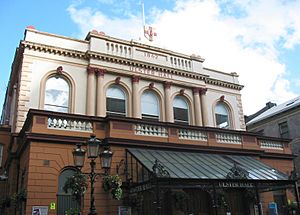
Many actors from Northern Ireland have become famous around the world.
- Stephen Boyd
- Kenneth Branagh – a well-known actor and director
- Ciarán Hinds
- Liam Neeson – a globally recognised actor
- James Nesbitt
- Stephen Rea
- Richard Dormer
- Conleth Hill
Film and Television
Northern Ireland Screen is a government group that helps fund film and TV shows made in Northern Ireland. They supported the HBO series Game of Thrones, which was filmed mostly in Belfast and other locations across Northern Ireland.
Belfast also hosts film festivals like the Belfast Film Festival and the CineMagic film festival, which often focuses on films for young people.
Music
Northern Ireland has a vibrant music scene with many famous musicians and bands.
- Ash
- Bicep (duo)
- Gary Moore
- Sir James Galway – a world-renowned flautist
- Nadine Coyle (from Girls Aloud)
- Snow Patrol
- Stiff Little Fingers
- Two Door Cinema Club
- The Undertones
- Therapy?
- Ulster Orchestra
- Van Morrison – a legendary singer-songwriter
Crafts
Every August, there's an event called August Craft Month. It's a programme that shows off the amazing work of craft makers from Northern Ireland and other parts of the UK, Ireland, and Europe. It's organised by Craft Northern Ireland.
Songs
A traditional song for some communities in Northern Ireland is The Sash. This song is part of the heritage of these groups and is often sung during celebrations.
Symbolism and Traditions
Different groups in Northern Ireland use different flags to show their identity. Some people often use the Union Flag (the flag of the United Kingdom) and sometimes the Ulster Banner. Others usually use the Flag of Ireland. Sometimes, people also use flags of their clubs or religious groups.
The Flag of St. Patrick is sometimes used by groups like the Irish Rugby Football Union because it represents Ireland without being linked to one specific political side.
The flax flower, which reminds people of the old linen industry, is sometimes used as a neutral symbol, for example, by the Northern Ireland Assembly.
St. Patrick's Day is celebrated by many people across Northern Ireland. Another important celebration is "The Twelfth", which takes place on July 12th.
On the Twelfth of July, large crowds gather to celebrate the anniversary of the Battle of the Boyne. The Apprentice Boys of Derry also organise special events to remember their history. The bowler hat is a symbol often seen during these celebrations.
See also
 In Spanish: Cultura de Irlanda del Norte para niños
In Spanish: Cultura de Irlanda del Norte para niños


